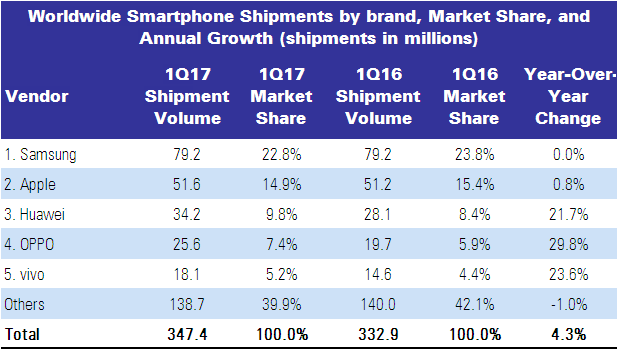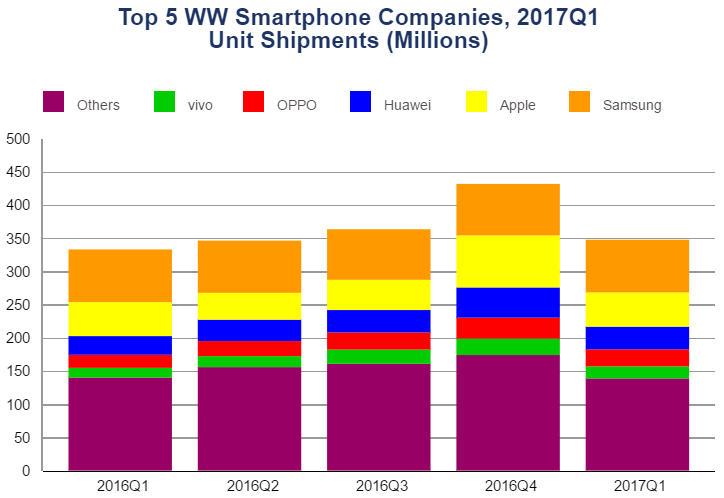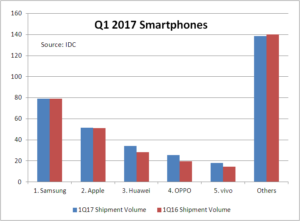IDC said that 347.4 million smartphones shipped in Q1 of 2017, up 4.3% on Q1 last year, up on the company’s forecast, with Chinese brands driving much of the growth as Huawei, Oppo, and Vivo all beat the growth in the market. They are expected to do even better as they extend the territories where they are active.
“The first quarter smartphone results further prove that the smartphone industry is not dead and that growth still exists,” said Ryan Reith, program vice president with IDC’s Worldwide Quarterly Mobile Device Trackers. “There is no question that 2016 was a pivotal year for the industry as growth dipped to low single digits for the first time. However, we believe the industry will show some rebound in 2017, and the strong first quarter results certainly support this argument. In addition to what shipped in 1Q17, big flagship announcements from Huawei with the P10 devices and Samsung with the Galaxy S8 devices show that innovation is still possible. And despite any formal announcements from Apple it is safe to say the industry is highly anticipating what comes from this year’s iPhone announcements.”
“Although we have seen an abundance of premium redesigned flagships that just entered the market, moving forward, we still expect most of the growth to come from more affordable models in a variety of markets” said Anthony Scarsella, research manager with IDC’s Worldwide Quarterly Mobile Phone Tracker. “Companies have started to implement a single premium design language that ultimately blurs the lines between the high-end and the low-end, allowing the average consumer to jump on the brand without a hefty upfront investment”.

Smartphone Company Highlights
Samsung went back to first place in the market despite a flat first quarter (0% year-over-year growth). Substantial discounts on the Galaxy S7 and S7 Edge helped move last year’s flagships. Outside of the high end, Samsung’s product mix continues to shift toward more affordable models. The J-Series and A-Series drove significant volumes in both emerging and developed markets thanks to flagship-like design at more affordable price points. IDC believes that a refreshed A7, A5, and A3 earlier this quarter, along with a recently updated J-Series, and new flagship S8/S8+ should give Samsung a well-balanced portfolio across all regions in Q2. An early positive response to the recently launched S8 and S8+ looks promising as it may have finally put Samsung’s Note 7 fiasco to bed.
Apple remained essentially flat with shipments reaching 51.6 million units in the first quarter, up slightly from the 51.2 million shipped last year. The strong holiday fourth quarter carried into the month of January as the larger iPhone 7 Plus returned to stock across most channels in numerous regions. Apple introduced a refreshed iPhone SE with more storage capacity (32GB and 128GB) that puts the mid-tier device in line with the rest of the iPhone portfolio. Rumours of a special edition 10th anniversary iPhone continue to grow as a pending new design, screen size, and performance upgrades all look to be in the works for the fall, IDC said
Huawei sustained its dominance in China growing nearly 22% as shipments climbed from 28.1 million units last year, to 34.2 million units in Q1 of 2017. Huawei once again demonstrated its stable position in the premium market with the P and Mate Series, and a strong presence in the affordable sector with its Y Series and Honor brand. Although Huawei announced earlier in the month that the Mate 9 has sold over 5 million units since it launched in November in the U.S., the device, as well as the brand, has failed to grab consumer’s attention. This U.S. attention is something Huawei will need if they aspire to displace the two market leaders. The launch of the new P10 flagship and the new P10 Plus at the very end of the quarter presents consumers a valid third option (outside of Apple and Samsung) for the coming quarter thanks to both premium design and similar performance.
Oppo’s midrange, camera-focused R9s was a crucial model in China that helped it to see strong shipments in the market. Oppo’s growth has in fact been stronger outside of China with nearly a quarter of shipments from international markets. In the rest of Asia and to a smaller degree in the Middle East and Africa regions, its strong retail presence has helped it to grow further in its business. It has been aggressive in both above-the-line and below-the-line activities in India, and stepped up with its after-sales service efforts in several Southeast Asian countries such as Indonesia by increasing its number of service centres.
Vivo also relied on a key model with the x9 in China that continued to generate a lot of hype around its selfie camera features, targeted at the under-30 market. It stepped up its marketing efforts in India and was a sponsor of the Indian Premier League 2017, helping to increase Vivo’s brand presence in the market, while also increasing the number of exclusive stores in India. In Southeast Asia, it continues to have its own promoters aggressively pushing its phones in the market. In Indonesia, it has also promised consumers single-day phone repairs as a differentiator to the competition.


